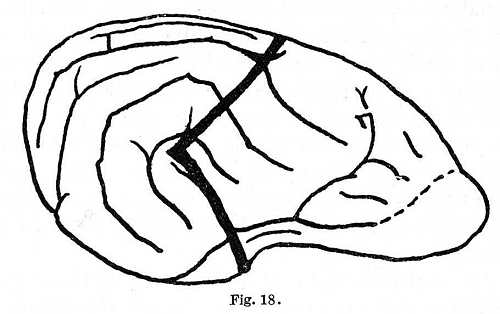
(Return to index)
Posted May 2001
[Classics Editor's note: Pavlov
used both square and round brackets in his texts. These have been preserved
but can lead to confusions as to which insertions are the author's and
which are the editor's. Page numbers, reference numbers, and the occasional
"sic" have been inserted in square brackets by the Classics editor.
All other insertions (e.g., on p. 31) are by Pavlov. -cdg-]
LECTURE XXI
Pathological disturbances of the cortex, result of surgical interference (continued): attempt to correlate the general post-operative behaviour of the animals with the disturbances in the activity of individual analysers.
It may be considered as firmly established that removal of the entire cerebral cortex converts the dog into a comparatively simple reflex machine. The animal retains the relatively limited number of unconditioned reflexes, but is completely deprived of the more complex and delicate co-ordination of its activities with the external world, since these adjustments are solely based upon innumerable conditioned reflexes established through the intermediation of the cerebral cortex. We possess also some knowledge as to the significance of different areas of the cortex -- the cortical analysers, the united function of which determines the complete adjustment of the organism with its surroundings, or, in other words, determines the behaviour of the animal. A great deal can be learned of the physiological activity of the cortex as a whole by careful observation of the general state of the animal after extirpation of definite cortical areas, whether such extirpations are free from post-operative complications or are complicated by a further disintegration of the cortex through the growth of scar tissue or by other secondary effects of the operation. The present lecture will be devoted to the description of changes in the general behaviour of the animal, and an attempt will be made to correlate these changes with the different structural lesions of the cortex. We shall start our description with simpler, going on to more complicated, cases.
In one dog the upper part of the hemispheres was extirpated above the level of the gyrus sylviaticus [experiments by Dr. Orbeli]. The extirpation was made by means of a single incision on each side, the operation being performed in two stages with a long interval of time between. A fortnight after the operation upon the second hemisphere the general state of the animal became definitely constant, [p. 362] remaining unchanged to the end of the experiments (4 months). As before, the animal was extremely lively, and when called reacted quickly, whipping round in the direction of the call. At a first glance its condition could not be distinguished from that of a normal dog. On closer observation, however, it was possible to observe a certain ataxy of the extremities, which on running were thrown up higher and brought down more vigorously than usual. Walking upon a smooth or wet floor the animal would very often slip; moreover, on starting off it always performed some peculiar movements with its head. When walking in a definite direction the animal seldom ran into any obstacle, but as soon as it did encounter an obstacle a surprising abnormality in its behaviour appeared. It became entirely helpless if it ran even against the narrow leg of a table; for a long time it would go on pressing forward, until slipping accidentally it would get by; and this was the only way in which the animal could continue its progression. When placed with the front part of its body on a chair and then called, the dog started disorderly scrambling movements and fell off the chair sideways, or sometimes, moving forwards, it contrived to get its whole body on to the chair, where it remained, helplessly kicking its hind legs in the air. The foregoing is a brief sketch of the general abnormality of the dog.
Coming now to the study of its conditioned reflexes, it was found that all those which were present before the second operation became, with the exception of tactile and thermal reflexes, quickly restored, while new conditioned reflexes to olfactory and visual stimuli were easily established. Unconditioned reflexes to various tactile and thermal cutaneous stimuli were present -- various "shaking," flexion and extension reflexes, responses by whining, howling and turning the head towards the point of application of the stimulus. I shall endeavour to correlate these deviations of the animal from normal with the disturbances of the functions of the different analysers. The activity of the olfactory and acoustic analysers was entirely unimpaired, and the activity of the visual analyser was only slightly disturbed. Remembering the peculiar movements of the head in locomotion, and taking into account that the animal was able to direct its movements by sight, it is obvious that a small portion of the lower part of the special nucleus of the visual analyser must have remained intact, allowing in certain positions of the head a higher synthesis and analysis of visual stimuli. [p. 363] In contrast, the motor analyser was radically damaged: the general locomotor activity which is effected by sub-cortical parts remained, while the precise and delicate activity of the skeletal muscles, so far at any rate as determined by conditioned reflexes, had disappeared. As regards the extent of damage of the tactile analyser we are not yet quite clear. It is obvious that the loss of the dog's ability to direct its movements when it ran into an obstacle in its path could be entirely explained by the loss of conditioned signals arising in the skin. However, such a total loss of tactile conditioned reflexes in case of this operation does not entirely fall into line with the results of some other experiments upon the localization of the cutaneous analyser (p. 347). The problem stands in need, therefore, of a thorough re-investigation. Excepting the inability to pass by any

mechanical obstacles, the behaviour of this animal, both free and during the experiments, showed no further abnormality. Dogs operated on in this manner are well worth a more precise and detailed analysis of their condition than we were able to perform in the early period of our work.
In other dogs, some of which have already been mentioned, the whole posterior part of the cortex of both hemispheres was removed behind the line shown in Fig. 18. We shall consider now the more general aspects of the behaviour of these dogs. It will be remembered that the higher analysis of auditory and visual stimuli was absent, altough the cruder analysis of different types of sounds, of the intensity of illumination and of different shapes was still present. Immediately after the final operation these animals kept sleeping almost continuously; afterwards during their whole lives (one dog suriving for three years) they spent their time mainly in sleep, and [p. 364] therefore with ample food they quickly fattened up. The animals located food exclusively with the help of the cutaneous and olfactory analysers, and in general the co-ordination of the activities of these analysers became most astonishing. When the animal was placed amid small pieces of meat thrown about the floor or suspended on threads at different heights, the lightest touch of any part of its body against a piece was sufficient to evoke a, most precise direction of its movements towards the piece of meat, which it took. Finally, the complete indifference of these animals to other dogs and to men, including their masters, should be especially noted. It is not difficult to understand the general passivity of these dogs (a characteristic already noticed by Goltz) and their great inclination to sleep, when one realizes how they lack to a large extent the activity of the main distance analysers -- visual and acoustic; hence also the extreme refinement of the activity of the analysers which are left, viz. the chemical analyser of smell, the cutaneous analyser, and the motor analyser. But the attention is startled by the general indifference of the animal to other dogs and men. It would be interesting to determine whether it was a result of their general diminution in reactiveness, or, as seems more probable, a result of a dropping out of compound visual and auditory stimuli as predominant stimuli, and the disappearance also of conditioned chain-reflexes.
I now pass on to the more complicated and at the same time the more instructive case -- that of extirpation of the anterior part of the hemispheres in front of the line shown in Fig. 18. The behaviour of animals operated upon in this manner deviates extremely from normal, and the analysis of this behaviour presents great interest. We had two such animals, and both survived the operation for about a year. The operation was performed in two stages, the two sides being operated with an interval of several months. I shall describe the first dog in full [experiment by Dr. Demeedov], and shall then give the main points of difference of the other dog [experiments of Drs. Satournov and Kouraev].
After the final operation the animal kept sleeping almost continuously, awakening only before micturition and defaecation. Food was introduced into the stomach directly, through a gastric fistula which had been established previously to the second stage of the operation. It was only at the beginning of the third week after the final operation that the animal began to get up and stand on its legs [p. 365] unassisted, and then only for a very short time, swaying from side to side and finally sinking down again. Approximately a month after the operation the dog started to walk. The paws, however, often twisted out of their normal position and the limbs often mutually obstructed one another, getting crossed. In another month walking amd running were practically normal, but, on whipping round suddenly, the dog could hardly preserve its balance. On meeting with obstacles the dog made disorderly scrambling movements, sometimes pushing forward and sometimes moving backwards or sideways; in some cases it would chance to slip by the obstacle, but most often it had to be helped. The animal was quite incapable of performing two different locomotor actions at the same time. As a result of such attempts it would lose its balance and topple over. This peculiarity remained to the end of its life. Two weeks after the operation the animal began to lap milk, but only when the milk was brought in contact with its mouth. The whole time it lived, the animal would only start eating when the food touched the mucous membrane of lips, cheeks or tongue. Contact of the skin around the mouth with the food did not initiate eating. During the latter part of its life the animal when hungry became very excited, grabbing at everything it could reach with its mouth, and even biting its own legs and paws, which would make it howl. From the time when the animal began to eat, alimentary substances were easily discriminated from non-alimentary substances, such as sand, or food containing quinine or a large amount of acid or salt. The motor reactions to a stimuli appeared about two weeks after the operation, and after this the cutaneous sensibility progressively increased, so that, afterer two to three months, touching the animal to put it into or take it out of the stand, or even simply stroking the animal, evoked violent general excitation. The dog would struggle to get loose, would bare its teeth and bark. Similarly, when it came into contact with objects through moving about, and in the yard when its fur got ruffled by wind, or when drops of rain fell upon it, the same motor excitation would occur. It is interesting that during these periods of excitation a gentle stroking of the neck and head quieted the animal, which sometimes even fell asleep. On scratching definite places of the skin a scratch-reflex was invariably evoked, and it was often observed that a simultaneous administration of an auditory stimulus caused an intensification of the scratch-reflex when the scratching was weak -- an example of the so-called "Bahnung- [p. 366] reflex." Motor reactions to sound, as expressed by pricking up and orientation of the ears, only reappeared l 1/2 months after the operation. The reactions gradually increased and sometimes were extraordinarily violent, so that even in response to comparatively weak sounds the animal showed pronounced general excitation. Under the influence of strong light the animal closed the eyes and turned the head away. Olfactory stimuli never produced any reaction, since the bulbus olfactorius and the olfactory tract were damaged on both sides. Sexual reflexes could never be detected under any conditions. No special relations either positive or negative to other animals or to men were ever observed. The animal sometimes had peculiar attacks lasting 1-8 minutes without any apparent cause -- tremor of the whole body, clonic contractions of the jaws with a cramp-like twisting of the head to one side, finishing up by ejection of urine and fæces. The convulsions were never observed in the body or extremities, and the animal did not fall down during the attacks. After an attack the animal became very excited, throwing itself about without any sense of direction, and barking; but finally it quieted down, got very drowsy and soon fell fast asleep.
The above general description of the animal seems to point to its having become entirely devoid of the higher nervous activity and transformed into a much simplified and inadequate reflex machine. Being similar in many respects to entirely decorticated animals, it was in many ways even less perfect in respect to locomotion. Indeed, animals after extirpation of the entire cortex begin to stand up much sooner after the operation, walk better and keep their balance better in different movements, than the dog just described. Judging by the state of the skeletal musculature, conditioned reflex activity appeared to be entirely lost. To determine whether this actually was the case we tried to analyse the condition of this dog by testing the reflex activity of the salivary gland.
The unconditioned salivary reflex had entirely disappeared immediately after the operation. It soon, however, returned, at first showing some deviations from normal which later righted themselves. Positive conditioned salivary reflexes, whether to visual, tactile, cutaneous or auditory stimuli, could not be established in spite of persistent attempts. In order to make doubly sure, even the dog's daily ration outside the experiments was now always [p. 367] accompanied by a sound of bubbling, but in spite of over five hundred repetitions no definite conditioned salivary reflex was ever obtained. After these failures stimulation was tried of that receptor surface which, as mentioned before, was generally found more resistant than any other in cases of extensive operations upon the cortex -- namely, the mucous membrane of the mouth, the receptor for the water-reflex. These experiments will now be described in detail. It will be remembered from the previous description that water when introduced into the mouth does not produce any salivary secretion unless it has previously been reinforced by a simultaneous introduction of some substance which acts as an unconditioned stimulus, e.g. the administration of aqueous solutions of rejectable substances such as acid. After a very large number of administrations of acid the dog now described, water first brought about a definite secretion a month after the operation, and systematic experiments this reflex could be started fifty days after the operation. After the acid had been frequently administered in the course of several days, water, when administered as the first stimulus on an experimental day, produced a copious secretion (16 drops and more during one minute). This salivary secretion disappeared after repeated introduction of the stimulus of water alone, undergoing extinction just like any other conditioned reflex. The following are some examples of extinction:
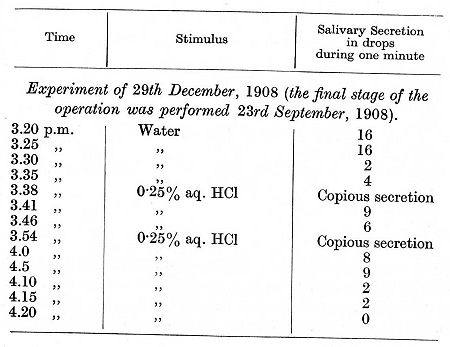
[p. 368]
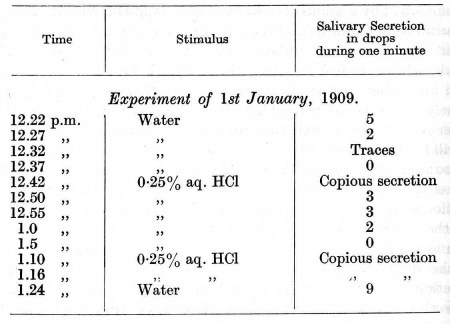
The conditioned water-reflex is as easily inhibited by different extraneous reflexes as are any other conditioned reflexes (external inhibition). The following are examples:
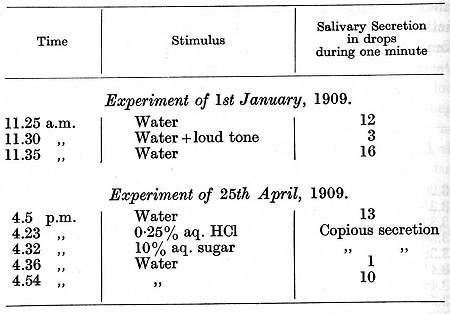
Since this form of inhibition (external inhibition) is, however, not peculiar to conditioned reflexes, a similar effect being observed also upon unconditioned reflexes, we resolved to develop a conditioned inhibition for the water-reflex -- i.e. to build up an actual inhibitory [p. 369] conditioned reflex (internal inhibition). It was expected that agencies belonging to other analysers, although incapable of acquiring positive conditioned properties, might nevertheless acquire the required negative conditioned properties, since examples of this had previously been observed (see p. 347). This expectation was fully justified, as it was found that both auditory and visual stimuli could serve successfully as conditioned inhibitors. Thus, administration of water simultaneously with sounding a definite tone became a constant inhibitory combination after 64 repetitions. The following are examples of experiments:
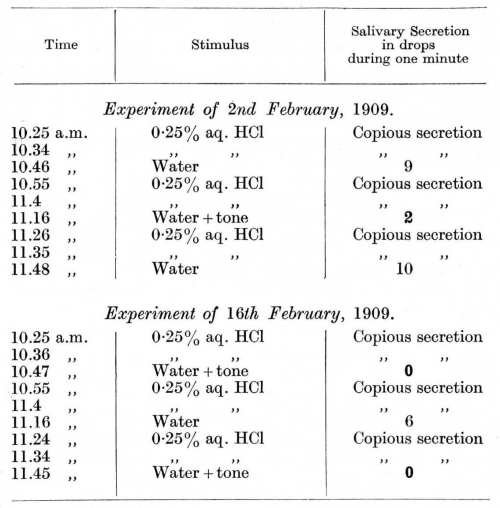
Similar results were obtained when an increased illumination of the room was used as the conditioned inhibitor, the acid, of course, always being introduced into the mouth in dim light. The conditioned inhibition developed much more quickly in this case, and the experiment given below represents the 16th administration of water with increased illumination. [p. 370]
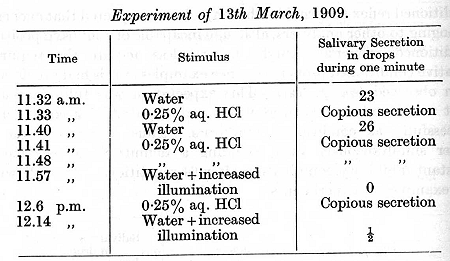
Finally, the effect of a die-inhibition of the water-reflex after experimental extinction was tried, and this was plainly revealed under the appropriate conditions as shown by the following experiment performed in presence of a large audience at a meeting of the Medical Society in Petrograd.
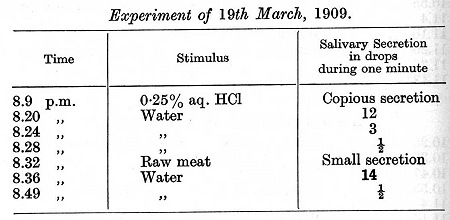
Stimulation by raw meat produced a dis-inhibition of the extinguished water-reflex only during the early period of its after-effect. Later, the effect of extinction returned temporarily, in accordance with the general rules of conditioned reflexes.
We see, therefore, that in the first dog only an organ of a secondary physiological importance, with only a rudimentary relation to the external world, remained functionally intact, namely, the salivary gland; and even this sole surviving witness could attest the continued functioning of the cerebral cortex only in conjunction with the rudimentary analyser of the mouth. [p. 371]
We shall now turn our attention to the second dog, which had a slightly different extent of lesion. In removing the anterior part of the hemisphere the bulbus and tractus olfactorius were preserved with the utmost care, since we wished if possible to demonstrate the existence of conditioned reflexes to olfactory stimuli, as well as the water-reflex.
The result exceeded our expectations. In this dog, besides the water-reflex, the conditioned reflex to an odour of camphor became re-established. The natural olfactory conditioned reflexes to food were of course also present. The dog stretched out its head towards food-directed by smell, and occasionally grabbed food placed close enough to it. This was the only important difference between the two dogs. In relation to other animals and to men the second dog was also entirely indifferent. The helplessness amongst mechanical obstacles and the defects in locomotion were as pronounced as in the first dog. Generally speaking this second dog was as great an invalid and as incapable of continuing to exist without careful tending as the first. No positive conditioned reflexes to stimuli belonging to other analysers could be obtained.
The post-mortem examination revealed in both dogs an extreme atrophy of the remaining posterior part of the hemispheres.
I think that the general behaviour of these animals can be more or less clearly interpreted by correlating our observations upon their conditioned activity and the result of the post-mortem examination. All the cortical parts of the analysers, with the exception of the analyser of the mouth in both dogs, and in the second dog of the chemical analyser of smell in addition, either did not function at all or else only partially (inhibitory reflexes). The dogs, therefore, were deprived of innumerable signalling stimuli from the external world, stimuli which otherwise would determine their normal complicated activities. In the first dog the only analyser to remain intact was the one which is the most limited in its contact with the environment. In the second dog, besides this there remained also the activity of the distance analyser of smell, which is especially well developed in dogs. In this dog, however, the analyser of smell mentioned neither so efficiently nor so constantly as in normal dogs. This may have been due to some damage of the analyser during the operation, or to its being constantly held under a certain inhibitory influence deriving from other analysers which had been damaged and which by themselves, although incapable of any positive activity, [p. 372] could yet respond to stimuli by the development and irradiation of an inhibition. The most important effector apparatus of the organism -- its skeletal and motor system -- was in both dogs incapable of performing its activities with the precision required for adjustment to changes in the external environment. Under normal conditions the activity of this system is determined by an associated action of two analysers, an external, cutaneous analyser -- signalling in detail changes in the external mechanical relations of the animal to its environment -- and an internal, motor analyser -- performing a detailed analysis and complicated synthesis of corresponding movements. In the case of extensive disturbances of either, it is obvious that detailed motor reactions in response to changes in the external environment cannot be present. There is evidence, however, that in these two dogs some irregularly dispersed parts of the cutaneous, and motor analysers still remained in the cortex, this being the probable explanation why stimulation of certain parts of the skin (stroking of the neck and head) undoubtedly evoked inhibitory (most probably conditioned) reflexes neutralizing the general excitation of the animal and leading to sleep, while stimulation of certain other parts evoked only unconditioned reflexes which are known to be the result of activity of the lower motor centres -- various scratch reflexes and defence reflexes. The same consideration may explain also the differences between these two dogs and entirely decorticated animals, namely, that the latter begin much sooner after the operation to get on their feet, stand, walk about, and in general show much less disorder in their movements than the two dogs described. The presence of dispersed remnants of the motor analyser is also indicated by the epileptic attacks in these two dogs, occurring in the form of convulsions of the muscles of the head, neck and sometimes body, but never of the extremities. As regards the absence of the special "social" reflexes sufficient has already been said. It is most probable that their existence depends on exceedingly complex conditioned reflexes, which in these dogs, of course, could not have been present, since even elementary positive conditioned reflexes were absent in the majority of the analysers.
I shall now discuss another case, the analysis of which occupied a very long time. This dog showed a great deviation from the normal in its general reactions, not immediately after the operation and not on account of the surgical lesion of the cortex itself, but under the influence of a subsequent growth of scar tissue accompanied [p. 373] by frequent attacks of convulsions, which two years after the operation became so severe as finally to lead to the death of the animal. The dog was young, very lively, and with a well-balanced nervous system. The experiments were started before the operation and confined to the development of tactile and thermal cutaneous reflexes which, as mentioned before, have an exceptional tendency to induce an inhibitory state of the cortical elements, dogs soon becoming drowsy under their influence and falling asleep. This dog, however, remained wide awake in its stand during the whole time of an experiment. The operation on the cortex was performed in two stages, first on the one and then on the other side (9th March and 28th April, 1910), the gyri postcruciati being partially destroyed. It was now for some time observed that stimulation of the areas of the skin corresponding to the cortical field of the operation produced drowsiness of the animal. This, however, was overcome by the introduction of a new strong conditioned stimulus (buzzer). After a short period of time all the small defects which developed after the operation almost completely disappeared and the dog behaved generally as normal. On the 11th May, 1910, it had a first attack of convulsions. Since the work that had been planned originally was at this time already completed, the dog was kept for a considerable time without observation. During the following summer the attacks of convulsions recurred, and in the autumn and winter the attendant looking after the animal reported that it had developed extremely peculiar behaviour and on being touched now entered into a state of extreme excitation, snarling, barking and baring the teeth in a manner which had never been observed before in this animal. In the beginning of January 1911 the dog was given over to Dr. Satournov. Its general behaviour was now as follows: Taken out of the kennel and placed on the floor it became wildly excited, soon, however, quieting down, after which it remained standing in the same place upwards of an hour at a time, only moving the head and sniffing the air. It would then make some forward or circular movement preliminary to defæcation or micturition, which quickly followed. Then it would continue standing in the same place. With the approach of the usual feeding time the dog would begin to walk about sniffing the air. A dish of food placed in front of it would make it stretch out its head after the food and even follow if the dish were removed. The act of eating was normal, the standing posture quite firm and without swaying, but as the dog [p. 374] walked the front legs would splay out, and when it turned quickly on a smooth floor the front legs would slip, but the animal would seldom fall. Sometimes the animal walked into obstacles, sometimes went round them. Sexual reflexes in spite of careful observations were never observed. The animal never answered to calling, and generally did not exhibit any reactions to other dogs or to men. If the hair on any part of the skin, especially of the neck and head, were touched however slightly by hand, other animals, wind, drops of rain, or any object with which the dog might come into contact, an extraordinary outburst of excitation followed, expressed by growling, barking, baring of the teeth and hostile movements generally. Usually the animal lifted up its head into the air and practically never turned it towards the point of origin of the touch. At the same time a continuous pressure upon the skin -- for example, by apparatuses attached to the skin during experiments, or by the loops of the stand -- left the dog quiet.
As was previously mentioned, the whole time the animal survived general attacks of convulsions recurred from which it usually recovered comparatively quickly. The conditioned reflex activity of this strange animal was studied in order to elucidate if possible the reason for its behaviour. An old conditioned alimentary reflex to a buzzer was easily and quickly re-established. A new conditioned reflex to a tone of an organ pipe of 300 d.v. was established, as was also a new reflex to an odour of camphor as well as a differentiation of the sound of another organ pipe three tones higher, and a conditioned inhibition of the reflex to camphor in conjunction with a metronome. The experimenter [Dr. Satournov did not succeed in re-establishing any of the tactile conditioned reflexes which were present before the pathological condition developed. He observed, however, that positive conditioned stimuli were in general very apt to develop inhibitory properties, and that the inhibitory process was extremely inert, exhibiting a very prolonged after-effect upon positive reflexes.
The next investigator who worked on this dog [Dr. Kouraev], realizing the peculiarity just mentioned, worked mainly with short-delayed reflexes, and succeeded without difficulty in re-establishing the reflexes to tactile stimuli. The tendency of the nervous system to inhibition continued to increase, as did also the occurrence and severity of the attacks of convulsions, until on the 19th May, 1912, vigorous attacks continuing with only short intermissions during twelve hours finally killed the animal. The post-mortem examination [p. 375] revealed, after removal of the scar, that the defect in the substance of the cortex involved the following convolutions -- the posterior part of the gyus postcruciatus, the anterior parts of the gyri suprasplenialis, entolateralis and ectolateralis, the gyrus suprasylvius medius, the upper half of gyrus coronarius, and to some extent the gyrus ectosulvius medius. The occipital and temporal lobes were definitely atrophied, the mass of the cortex in these two areas diminished and the convolutions flattened out. The frontal lobes remained apparently entirely intact.
The post-mortem examination showed that the actual destruction involved in the main the posterior part of the cortex, the anterior part being affected to a much smaller extent. Naturally therefore the behaviour of this dog, as shown by observation of its conditioned reflexes, resembled that of animals in which the posterior part of the cerebral cortex had been extirpated. The animal was, unfortunately, not subjected to analysis of reflexes to compound auditory and visual stimuli. The absence of such reflexes could, however, be inferred from the fact that the dog did not react to calling and did not exhibit any social relations with other animals or with men, indicating an absence of chain, and probably all complex, reflexes. Certain irregularities in walking obviously depended upon a small damage of the motor analyser. It is difficult, however, to find an adequate explanation for the prolonged standing of the dog in one place and the exaggerated reactions to touching the skin. So far as the former is concerned it is impossible to decide whether it is an expression of a dominance of inhibition in the cortex subsequent to the periods of violent excitations (convulsions), or whether it should be regarded as a result of a partial damage of the cutaneous analyser. The latter explanation would seem to find support in the retention of the usual mobility of the head and neck. The exaggerated reaction to touching the skin might be of cortical origin or a reflex through subcortical centres. Since, however, tactile conditioned reflexes were present, the latter seems improbable. It is also difficult to reconcile the extreme excitability of the cutaneous analyser with the hypothesis of a predominance of the inhibitory process in the cortex. To solve these problems it would have been necessary to perform further variations of the experiments, and these were not at that time practicable.
In describing the cases in the present lecture; I do not make the slightest pretence to have given a satisfactory explanation of the [p. 376] entire nervous mechanism underlying the deviations from normal in the general behaviour of the dogs after surgical damage of the cortex. My aim has been simply to show that problems as to this mechanism are the legitimate province of physiology, and to demonstrate that a reasonable possibility of studying them is given even by present-day methods.
On the whole the experiments upon conditioned reflexes brought forward in the last three lectures confirm the observations of old and recent authors upon the same problem, though we have also been able to add some new facts and to formulate some new problems. But what our experiments do most emphatically refute is the doctrine of special "association" centres, or, more generally, of the existence in the hemispheres of some special area on which the higher functions of the nervous system depend -- a doctrine which has already been strenuously opposed by H. Munk.